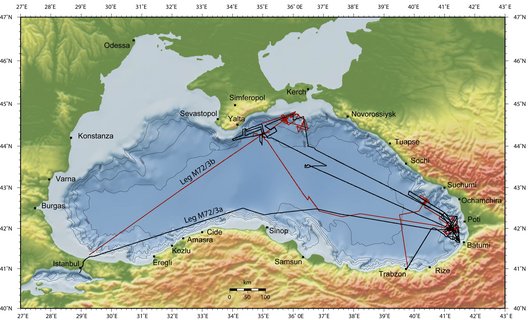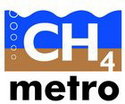Page path:
- Home
- Research
- Expeditions
- 2007
- M72/3a
RV METEOR M72/3a+b

M72/3a: Istanbul – Trabzon (16. March – 03. April 2007)
M72/3b: Trabzon – Istanbul (04. April – 23. April 2007)
Summary
During the expedition (MARGASCH II) the distributions and dynamics of methane and gas hydrates at active fluid emissions sites as well as in areas without seepage in the Eastern Black Sea were examined. Near-bottom gas hydrates are in particular of relevance for climatic topics, stabilities of sediments and geobiological processes and were explored by various high-resolution geophysical, geochemial and geological methods.
Working Areas
The Black Sea is most suitable for the investigations carried out, since it is the epicontinental sea containing highest methane concentrations which are sourced by hundreds of methane seeps. During legs M72/3a and 3b diverse geological structures were investigated. Main target areas were active gas and oil seeps offshore Batumi (Georgia) and mud volcanoes in the Sorokin Trough (Ukraine).

Fig. 1 Cruise tracks of expeditions METEOR 72/3a and 3b. Major working areas were seep locations offshore Georgia and mud volcanoes in the Sorokin Trough east off the Crimean Peninsula.
In the working areas deposits of gas hydrates were visualized by different seismic methods using a wide spectrum of signal frequencies and methods available in order to detect dimensions and geometries of such occurrences, as well as migration pathways from underlying strata. Combining results from seafloor mapping using the ROV ''QUEST 4000m'', geochemical studies in the water column, and samplings of gas hydrates and sediments, these activities highlighted the distribution and quantification of different methane phases in the sediment. Of great relevance for the quantifications of methane were novel autoclave tools, which for the first time offered the possiblity to determine authentic methane concentrations in the sediment and to differntiate between gas and hydrate phases.

The Remotely Operated Vehicle ''QUEST4000m'' during launch

Deployment of the Dynamic Autoclave Piston Corer (DAPC)
Scientific Programme
Cruise M72/3 was separated into two legs. ROV-dives were performed during the first leg, while sidescan sonar measurements and seismic studies were carried out during the second one.
The ROV QUEST was the most important tool during the first Leg (M72/3a). The ROV not only facilitated exact sampling at the seafloor, but also the localisation of bubble emission sites by use of its on-board sonar. Sampling with the use of QUEST was conducted with conventional tools, and with an autoclave-container especially designed for QUEST enabling to seal the samples under in-situ pressure. Additionally, sampling by conventional (TV-MUC) and autoclave (DAPC) coring tools, as well as acoustical imaging of methane flares was carried out.
During the second Leg (M72/3b) those sites which have already been explored during M72/3a were inspected again, in order to perform intense investigations by sidescan sonar and multichannel seismics. Furthermore, a mobile computertomography (CT)-scanner was deployed on board the ship. Upon recovery of pressurized cores by use of the DAPC, the CT-system facilitated the determination of structures and textures of gas hydrate bearing sediments. Subsequent to the CT-scanning the autoclave core was degassed quantitatively in order to assess the total amounts of methane and gas hydrates (Heeschen et al., subm.). Additional sampling using the TV-MUC completed the working programme.
The ROV QUEST was the most important tool during the first Leg (M72/3a). The ROV not only facilitated exact sampling at the seafloor, but also the localisation of bubble emission sites by use of its on-board sonar. Sampling with the use of QUEST was conducted with conventional tools, and with an autoclave-container especially designed for QUEST enabling to seal the samples under in-situ pressure. Additionally, sampling by conventional (TV-MUC) and autoclave (DAPC) coring tools, as well as acoustical imaging of methane flares was carried out.
During the second Leg (M72/3b) those sites which have already been explored during M72/3a were inspected again, in order to perform intense investigations by sidescan sonar and multichannel seismics. Furthermore, a mobile computertomography (CT)-scanner was deployed on board the ship. Upon recovery of pressurized cores by use of the DAPC, the CT-system facilitated the determination of structures and textures of gas hydrate bearing sediments. Subsequent to the CT-scanning the autoclave core was degassed quantitatively in order to assess the total amounts of methane and gas hydrates (Heeschen et al., subm.). Additional sampling using the TV-MUC completed the working programme.

Lifting of the computerized tomography trailer on board R/V METEOR in the port of Trabzon
Scientific Objectives
Overarching goal of the research during M72/3a and 3b was a better understanding of the distributions and dynamics of methane and gas hydrates in sediments of the Black Sea, as well as of the origin of methane and its fluxes from the sediment to the water column. The main focus was laid on the gas hydrate transition zone, i.e. in water depths of about 700 m, at which the boundary of the gas hydrate stability field and the sea floor cross. However, the results of our pre-examinations and of M72/3 demonstrated that gas hydrates might even develop in sediments of mud volcanoes in the deep Black Sea very close to the gas hydrate stability curve, since elevated heat fluxes and the presence of relative saline waters lead to a shift of the curve (Bohrmann et al., 2003).
The specific goals of the research cruise were as follows:
• Quantitative assessment of the distributions of near-surface gas hydrates with the use of sidescan sonar and further mapping methods, like TV-slet profiling, ROV mapping including ‘mosaicking’.
• Compilation of high-resolution illustrations of sub-surface structures (supplying channels, mud migration pathways, diapiric structures, as well as gas and gas hydrate accumulations) by means of multichannel seismic examinations.
• Determination of structures and textures of gas hydrate-bearing sediments by CT-scanning of cores recovered by autoclave coring tools under in-situ pressure. Beside the quantification of the amounts of gas hydrates contained in sediments, the proportion of free gas will be analysed and profiled with sediment depth. The data are fundamental for the interpretation of the dynamics of methane and gas hydrates in near-surface sediments.
• Description of the fate of dissolved and adsorbed methane in sediments obtained by autoclaves and subautoclaves, respectively, by means of quantitative degassing.
• Characterization of gas hydrate dynamics, genesis of carbonates, flux rates and pore water chemistry, as well as their three-dimensional distributions by geochemical and modelling methods.
The specific goals of the research cruise were as follows:
• Quantitative assessment of the distributions of near-surface gas hydrates with the use of sidescan sonar and further mapping methods, like TV-slet profiling, ROV mapping including ‘mosaicking’.
• Compilation of high-resolution illustrations of sub-surface structures (supplying channels, mud migration pathways, diapiric structures, as well as gas and gas hydrate accumulations) by means of multichannel seismic examinations.
• Determination of structures and textures of gas hydrate-bearing sediments by CT-scanning of cores recovered by autoclave coring tools under in-situ pressure. Beside the quantification of the amounts of gas hydrates contained in sediments, the proportion of free gas will be analysed and profiled with sediment depth. The data are fundamental for the interpretation of the dynamics of methane and gas hydrates in near-surface sediments.
• Description of the fate of dissolved and adsorbed methane in sediments obtained by autoclaves and subautoclaves, respectively, by means of quantitative degassing.
• Characterization of gas hydrate dynamics, genesis of carbonates, flux rates and pore water chemistry, as well as their three-dimensional distributions by geochemical and modelling methods.
References
Abegg F., Hohnberg H.-J., Pape T., Bohrmann G., Freitag J. (subm.) Development and application of pressure core sampling systems for the investigation of gas and gas hydrate bearing sediments. Deep Sea Research I.
Blinova, V., M. Ivanov and G. Bohrmann (2003). "Hydrocarbon gases in deposits from mud volcanoes in the Sorokin Trough, north-eastern Black Sea." Geo-Marine Letters 23: 250-257.
Bohrmann, G., M. Ivanov, J.-P. Foucher, V. Spiess, J. Bialas, J. Greinert, W. Weinrebe, F. Abegg, G. Aloisi, Y. Artemov, V. Blinova, M. Drews, F. Heidersdorf, A. Krabbenhöft, I. Klaucke, S. Krastel, T. Leder, I. Polikarpov, M. Saburova, O. Schmale, R. Seifert, A. Volkonskaya and M. Zillmer (2003). "Mud volcanoes and gas hydrates in the Black Sea: new data from Dvurechenskii and Odessa mud volcanoes." Geo-Marine Letters 23: 239-249.
Heeschen, K.U., H.-J. Hohnberg, F. Abegg, M. Haeckel, M. Drews, G. Bohrmann (2007) "In situ hydrocarbon concentrations from pressurized cores in surface sediments, Northern Gulf of Mexico." Marine Chemistry 107:498-515.
Klaucke, I., H. Sahling, D. Bürk, W. Weinrebe and G. Bohrmann (2005). "Mapping deep-water gas emissions with sidescan sonar." EOS, Transactions, 86: 341-352.
Klaucke, I., H. Sahling, W. Weinrebe, V. Blinova, D. Burk, N. Lursmanashvili and G. Bohrmann (2006). "Acoustic investigation of cold seeps offshore Georgia, eastern Black Sea." Marine Geology 231: 51-67.
Krastel, S., V. Spiess, M. Ivanov, W. Weinrebe, G. Bohrmann, P. Shashkin and F. Heidersdorf (2003). "Acoustic investigations of mud volcanoes in the Sorokin Trough, Black Sea." Geo-Marine Letters 23: 230-238.
Wagner-Friedrichs M, Krastel S, Spiess V, Ivanov M, Bohrmann G & Meisner L (subm.) 3D seismic investigations of the Sevastopol mud volcano in correlation to gas/fluid migration pathways and gas hydrates occurrences in the Sorokin Trough (Black Sea). G-cubed.
Wagner-Friedrichs M, Meisner L, Krastel S & Spiess V (subm.) Characterization of Mud volcanoes in the Sorokin Trough (Black Sea) from acoustic data. Marine Geology.
Blinova, V., M. Ivanov and G. Bohrmann (2003). "Hydrocarbon gases in deposits from mud volcanoes in the Sorokin Trough, north-eastern Black Sea." Geo-Marine Letters 23: 250-257.
Bohrmann, G., M. Ivanov, J.-P. Foucher, V. Spiess, J. Bialas, J. Greinert, W. Weinrebe, F. Abegg, G. Aloisi, Y. Artemov, V. Blinova, M. Drews, F. Heidersdorf, A. Krabbenhöft, I. Klaucke, S. Krastel, T. Leder, I. Polikarpov, M. Saburova, O. Schmale, R. Seifert, A. Volkonskaya and M. Zillmer (2003). "Mud volcanoes and gas hydrates in the Black Sea: new data from Dvurechenskii and Odessa mud volcanoes." Geo-Marine Letters 23: 239-249.
Heeschen, K.U., H.-J. Hohnberg, F. Abegg, M. Haeckel, M. Drews, G. Bohrmann (2007) "In situ hydrocarbon concentrations from pressurized cores in surface sediments, Northern Gulf of Mexico." Marine Chemistry 107:498-515.
Klaucke, I., H. Sahling, D. Bürk, W. Weinrebe and G. Bohrmann (2005). "Mapping deep-water gas emissions with sidescan sonar." EOS, Transactions, 86: 341-352.
Klaucke, I., H. Sahling, W. Weinrebe, V. Blinova, D. Burk, N. Lursmanashvili and G. Bohrmann (2006). "Acoustic investigation of cold seeps offshore Georgia, eastern Black Sea." Marine Geology 231: 51-67.
Krastel, S., V. Spiess, M. Ivanov, W. Weinrebe, G. Bohrmann, P. Shashkin and F. Heidersdorf (2003). "Acoustic investigations of mud volcanoes in the Sorokin Trough, Black Sea." Geo-Marine Letters 23: 230-238.
Wagner-Friedrichs M, Krastel S, Spiess V, Ivanov M, Bohrmann G & Meisner L (subm.) 3D seismic investigations of the Sevastopol mud volcano in correlation to gas/fluid migration pathways and gas hydrates occurrences in the Sorokin Trough (Black Sea). G-cubed.
Wagner-Friedrichs M, Meisner L, Krastel S & Spiess V (subm.) Characterization of Mud volcanoes in the Sorokin Trough (Black Sea) from acoustic data. Marine Geology.
Funding
The research accomplished during M72/3a and 3b (MARGASCH II) is part of the BMBF joint project METRO funded in the framework of the special programme ‘Geotechnologies’ within the subject area ‘Methane in the geo-/biosystem’. METRO is also embedded in the German-Russian agreement on ‘Co-operations on the realm of marine and polar research’. The activities of MARGASCH II are based on former expeditions with RV Poseidon P317/4 and RV Professor Logatchev TTR-15 in 2004 and 2005, respectively.

High-resolution multichannel surface streamer

Seismic profile from Sorokin Trough, Black Sea

PARASOUND echograph of active area in the Black Sea used to detect and localize methane seeps.

Preparations of gas samples



